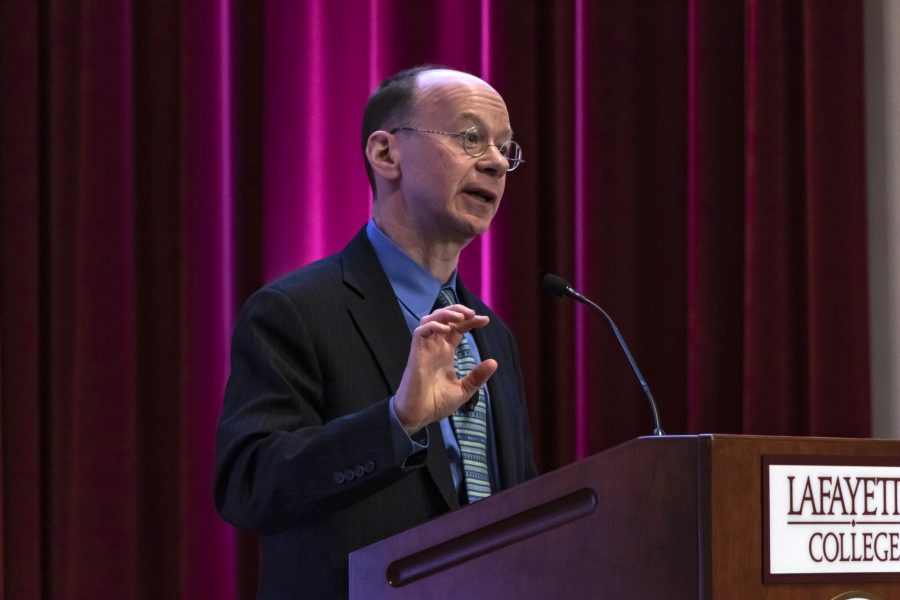Alan Cooperman, the Director of Religion Research at the Pew Research Center, spoke in Colton Chapel this past Wednesday on the role of religion in the U.S. and in the world. He spoke as part of the Lafayette Symposium, a viewpoint-diversity initiative driven by a committee, which recommends speakers to President Alison Byerly’s office.
Cooperman explained, using widespread data from multiple countries, that more evidence is being applied to debunk myths about people affiliated or unaffiliated with religion. He discussed the idea of the “nones,” Americans that are religiously unaffiliated, and their role in his religious research.
According to Cooperman, seven percent of “nones” are atheist, while others are unaffiliated people who are sometimes religious or spiritual.
There has been an increase in the United States of “nones” from 17 percent in the 1970s to 22 percent today. Cooperman explained that there are two primary causes, generational replacement and religion switching. He noted that, since the Silent Generation and Baby Boomers, religious affiliation has slowly declined.
Cooperman also emphasized that a common myth about “nones” is that they do not practice or believe in a higher power. However, in the Millennial and Gen X generations, noted for being far less religious than the preceding generations, Cooperman said that many “nones” are still involved in religious practices such praying and attending church.
Cooperman pointed out that older generations are more religious, while younger people tend to be more secular. He added that younger, unaffiliated populations tend to be more liberal. He also presented a graph showing the relationship between GDP per capita and the religiosity of a country. He noted that countries with a lower GDP per capita are almost always more religious, with two notable exceptions—the US and China.
By doing so, Cooperman said that “there is a pattern between GDP and religion devotion in these countries such as, Senegal, India, Ghana, etc., the are highly religious with a negative correlation in GDP.”
Cooperman spoke on his previous work overseas for the Associated Press and U.S. News & World Report. He noted that he was placed as a foreign correspondent in highly religious areas, such as the Post-Soviet region and the Middle East.
After returning home, Cooperman said he began focusing on religion and its interaction with national security, culture and the United States’ relationship with other countries. He was an editor for the Washington Post, drifting away from religious coverage and into government news.
After seeking a change back to religious studies, Cooperman said he applied himself to research at the Pew Research Center in Washington, DC. Several years later, Cooperman became the Director of Religion Research.
“I lead a team of 25 people or so, we have political scientists, sociologists and many others, working to provide data on religious practices around the world,” said Cooperman.
Cooperman collected preparatory work in Southeast Asia, Western Europe, and Northern Africa during his research at Pew.
“We are a nonpartisan and nonprofit organization, we do not try to support one religion over another, we provide the data and summarize our findings. That’s all,” he said.
Cooperman explained that Pew provides the data for religious leaders and other organizations to utilize and interpret, such as through the collection of prayer practices, or if a person is unaffiliated with a religion.
Cooperman said that his team focuses on attaining research values and participants. The Pew Religious Research group collaborates with worldwide interpreters and field agents to evade issues with translating and capturing data from non-English speaking countries.
Cooperman also elaborated on the data collection process.
“We use certain techniques for different regions. In a highly populated area where cell phones are widely used, we would use an online survey method or calling them directly,” Cooperman said. “Those that lack service are included, in a randomized technique of door-to-door and things like that.”
“Field agents will base their randomization off a random feature like, ‘whose birthday is in March,'” he added.
Cooperman explained the intricacies of cultural aspects that had to be taken into account when conducting research. He added that in predominantly Muslim countries “women are less likely to answer the door, so our sample would not be randomized and feature all males.”
By understanding these normalized responses, Cooperman said we can start unpacking cultural norms and religious influence on various social infrastructures. Cooperman continues to advocate for providing this information, but leaves individuals and institutions to interpret the values for themselves.




































































































